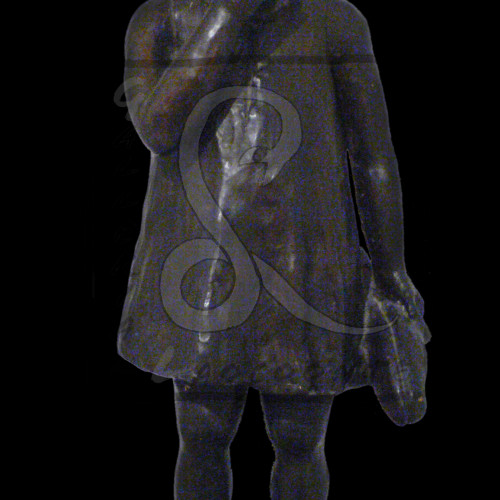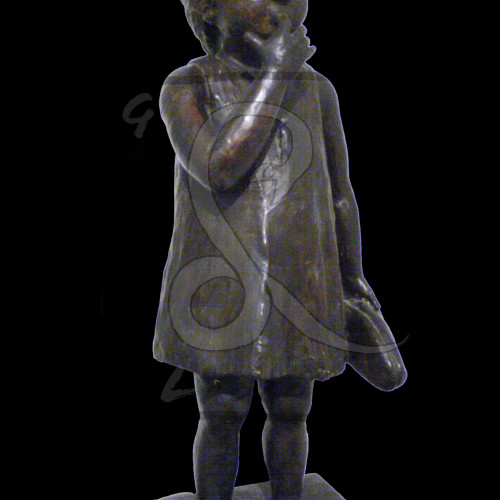 Angelo Biancini was born in Castelbolognese in 1911. In 1929 he enrolled at the Art Institute of Florence where, above all, he attended the classes of Libero Andreotti, a teacher for whom he would always show appreciation and respect. His first studio was a large room in a former convent, where he devoted himself primarily to maiolica, before moving towards modelling and sculpture. In 1932 he began to exhibit his works in public, and in 1934 came his first statement, with his ‘Lupa’ winning the sculpture section of ‘Littoriali dell’arte’ in Rome. Also in 1934 he participated for the first time at the Venice Biennale. Following on from this he designed objects which were then made by ENAPI to take part in ‘VI Triennale di Milano’. In 1935, he created the statue of the victorious Athlete in the Foro Mussolini (now Stadio dei Marmi) in Rome. Also in Rome in 1935 he exhibited at ‘II Quadriennale d’arte Nazionale’, and in 1937 he made two sculptures for ‘Ponte della Vittoria’ in Verona. From 1937 to 1940 he lived in Laveno, collaborating with Guido Andlovitz and contributing to the artistic direction of ‘Soceita Ceramica Italiana’. During his years in Laveno, Biancini strengthened his relationship with ceramics (between object, portrait and monumental sculpture). In 1942 he entered the Art Institute for Ceramics in Faenza and, post-war, he succeeded Domenico Rambelli as the Head of Plastic Art. By this time the figure of Biancini had emerged as one of the most prominent among the new generation of Italian sculptors. In addition to teaching, he continued to create new work, with participation in the most important national art competitions, for which he received unanimous praise, even winning the national award at the ‘Quadriennale Romana’ in 1943. At two further exhibitions in Milan, 1948 and 1956, at ‘Galleria San Fedele’ he attracted yet more critical acclaim across the nation. The following years brought many awards: at the Palace of Exhibitions Milan he won the Bagutta for sculpture (1961). In the same year, he also won an award with the bronze ‘St. John in the Desert’ at the International Exhibition ‘Arte Sacra di Trieste’, where he won again in 1963 with ‘The Sacred Shepherd’. Of particular significance are the relief in the Basilica of Nazareth (1959), the canopy of the Temple of the Canadian Martyrs in Rome (1961), and the sculptural cycle for the Hospital Maggiore in Milan (1964). In 1973, two events were organised in his honour in Rome: at Palazzo Braschi, where a complete overview of his sculptures in bronze was shown, he was also given his own room in the Religious Modern Arts Collection of the Vatican Museums. In 1980, the Municipality of Faenza gave, with a gold medal, honorary citizenship and at the same time prepared a major tribute to the ‘Palazzo delle esposizioni’. In 1981, he reached the age of retirement, leaving the Art Institute of Faenza and continuing to work in a studio in the immediate vicinity. He died in Castelbolognese in 1988, the small town where he was born.
Angelo Biancini was born in Castelbolognese in 1911. In 1929 he enrolled at the Art Institute of Florence where, above all, he attended the classes of Libero Andreotti, a teacher for whom he would always show appreciation and respect. His first studio was a large room in a former convent, where he devoted himself primarily to maiolica, before moving towards modelling and sculpture. In 1932 he began to exhibit his works in public, and in 1934 came his first statement, with his ‘Lupa’ winning the sculpture section of ‘Littoriali dell’arte’ in Rome. Also in 1934 he participated for the first time at the Venice Biennale. Following on from this he designed objects which were then made by ENAPI to take part in ‘VI Triennale di Milano’. In 1935, he created the statue of the victorious Athlete in the Foro Mussolini (now Stadio dei Marmi) in Rome. Also in Rome in 1935 he exhibited at ‘II Quadriennale d’arte Nazionale’, and in 1937 he made two sculptures for ‘Ponte della Vittoria’ in Verona. From 1937 to 1940 he lived in Laveno, collaborating with Guido Andlovitz and contributing to the artistic direction of ‘Soceita Ceramica Italiana’. During his years in Laveno, Biancini strengthened his relationship with ceramics (between object, portrait and monumental sculpture). In 1942 he entered the Art Institute for Ceramics in Faenza and, post-war, he succeeded Domenico Rambelli as the Head of Plastic Art. By this time the figure of Biancini had emerged as one of the most prominent among the new generation of Italian sculptors. In addition to teaching, he continued to create new work, with participation in the most important national art competitions, for which he received unanimous praise, even winning the national award at the ‘Quadriennale Romana’ in 1943. At two further exhibitions in Milan, 1948 and 1956, at ‘Galleria San Fedele’ he attracted yet more critical acclaim across the nation. The following years brought many awards: at the Palace of Exhibitions Milan he won the Bagutta for sculpture (1961). In the same year, he also won an award with the bronze ‘St. John in the Desert’ at the International Exhibition ‘Arte Sacra di Trieste’, where he won again in 1963 with ‘The Sacred Shepherd’. Of particular significance are the relief in the Basilica of Nazareth (1959), the canopy of the Temple of the Canadian Martyrs in Rome (1961), and the sculptural cycle for the Hospital Maggiore in Milan (1964). In 1973, two events were organised in his honour in Rome: at Palazzo Braschi, where a complete overview of his sculptures in bronze was shown, he was also given his own room in the Religious Modern Arts Collection of the Vatican Museums. In 1980, the Municipality of Faenza gave, with a gold medal, honorary citizenship and at the same time prepared a major tribute to the ‘Palazzo delle esposizioni’. In 1981, he reached the age of retirement, leaving the Art Institute of Faenza and continuing to work in a studio in the immediate vicinity. He died in Castelbolognese in 1988, the small town where he was born.



